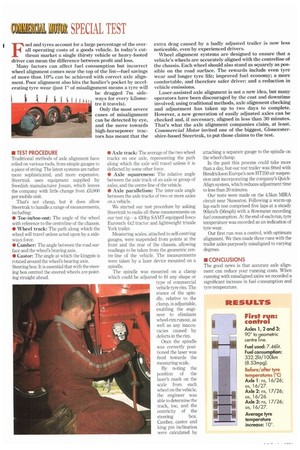(MEM SPECIAL TEST F uel and tyres account for a large
Page 28

If you've noticed an error in this article please click here to report it so we can fix it.
percentage of the overall operating costs of a goods vehicle. In today's cutthroat market a single thirsty vehicle or heavy-footed driver can mean the difference between profit and loss.
Many factors can affect fuel consumption but incorrect wheel alignment comes near the top of the list—fuel savings of more than 10% can be achieved with correct axle alignment. Poor alignment also hits the haulier's pocket by accelerating tyre wear (just 10 of misalignment means a tyre will be dragged 7m sideways for every kilometre it travels).
Only the most severe cases of misalignment can be detected by eye, and the move towards high-horsepower tractors has meant that the extra drag caused by a badly adjusted trailer is now less noticeable, even by experienced drivers.
Wheel alignment systems are designed to ensure that a vehicle's wheels are accurately aligned with the centreline of the chassis. Each wheel should also stand as squarely as possible on the road surface. The rewards include even tyre wear and longer tyre life; improved fuel economy; a more comfortable, and therefore safer driver; and a reduction in vehicle emissions.
Laser-assisted axle alignment is not a new idea, but many operators have been discouraged by the cost and downtime involved; using traditional methods, axle alignment checking and adjustment has taken up to two days to complete. However, a new generation of easily adjusted axles can be checked and, if necessary, aligned in less than 30 minutes. That's what the axle alignment companies claim, at least. Commercial Motor invited one of the biggest, Gloucestershire-based Steertrak, to put those claims to the test.








































































































